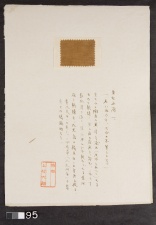Difference between revisions of "Matami/Inugusu/Tabu no ki - center (95 C)"
Jump to navigation
Jump to search
(username removed) |
(username removed) |
||
| Line 1: | Line 1: | ||
| − | {| class="wikitable" | + | [[[SliderGallery rightalign|Uemura_05-29-2009_095.jpg~Normal]]]{| class="wikitable" |
|- | |- | ||
! scope="row"|Museum number | ! scope="row"|Museum number | ||
Revision as of 09:32, 8 June 2013
| Museum number | 95 |
|---|---|
| Uemera number / title | 一; 櫨染 廿五 "Haze-some 25" |
| Folder location | 2nd shelf |
| Sample location | center (95 C) |
| Fiber type | silk |
| Color | brown (orangish) |
| Dyestuff (Japanese common name) | またみ/いぬぐす/たぶの木 : Matami/Inugusu/Tabu no ki |
| Dyestuff (botanical name) | Machilus thunbergii Siebold et Zucc. |
| Plant part | bark /dried (?) |
| Dyestuff extraction | boiled in water |
| Auxiliary agent in dye bath | - |
| Mordant | - |
| Other auxiliary agent | ash water |
| Uemera's notes | The fabric was soaked in a bath containing the dye extract and ash water; and then dried. This process was repeated for more than ten times. After the final drying, the fabric was soaked into ash water, dried, and then rinsed with water. This technique is used for dyeing a brown of those textiles made in Hachijyō island (八丈島), Japan. Their stripe pattern, called "Kihachijyō (黄八丈)" consists of this brown and a yellow dyed with Arthraxon hispidus (Thunb.) Makino, so-called "Kobuna-gusa /Hachijyō-Kariyasu". |
| Uemera's date | Kyoto |
